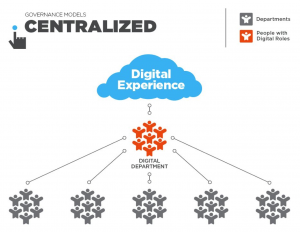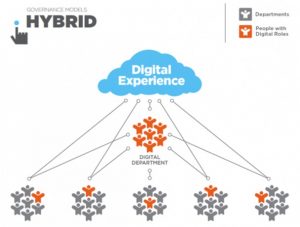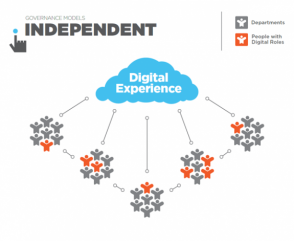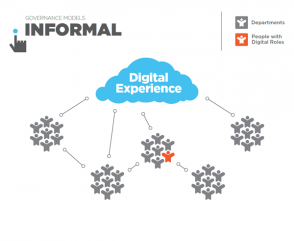How do you structure your digital engagement team? Has that structure changed in the last 3 years, and is it working? How well do you collaborate with other departments with fingers in digital? What are the biggest areas of growth, opportunity, and tension in your org right now?
Earlier this summer we were approached with these questions and more by two senior colleagues, who like me are big organizational structure geeks and fans of our Digital Teams Survey. We’ve decided to update it with fresh data for 2017, to start a new conversation about innovation structures in the field today.
If you’re responsible for digital engagement at an org that does advocacy, please take our survey now.
In the meantime, here is a refresher on the four models of digital teams, where we humbly propose a new fifth model.
The classic: Centralized teams
Centralized teams are where most if not all digital work is managed by one team.

This model has lost a lot of ground recently, as it lacks the responsiveness, dynamism, and distributed nature of how most institutions have adapted to manage digital innovation on so many fronts. Basically, you put digital in a silo (typically comms), hire a smart person to run it, and it serves the institution from this central place. Benefits include brand consistency, common tools, and clear reporting lines. Unfortunately, these teams can be slow to respond to change, are always at or beyond capacity, and can get bogged down in heavy processes that stifle creativity. They don’t enable an organization to grow capacity or become digital-first, and as such we don’t recommend this model for organizations who take engagement seriously.
The progressive challenger: Hybrid teams
Hybrid teams are where digital roles are distributed where they are needed, yet a central team still drives strategy and leads some key functions.

For years we’ve recommended this as the model most conducive to engagement and innovation. Different departments can grow their own capacity based on their specific needs, but all digital staffers are connected to and supported by a central digital team focused on a few core competencies and directing the whole system toward long-term strategic goals. Some newer hybrid models even see the central team responsible only for strategy, and a “product management” team leading digital execution.
The culture of the central digital group is one of “open” or collaborative leadership, where they are sought after for their advice and interested in sharing knowledge and helping others succeed. The core team maintains leadership of high-risk projects themselves, but leaves space for others to lead on their own priorities.
Our 2014 digital teams report found this to now be the most common model for teams in larger orgs, which surprised us (in a pleasant way). It may sound ideal, but pulling it off requires an enabling institutional environment that is comfortable with collaboration and organic reporting structures, still difficult in a hyper-silo’d, top down institution that operates within a control paradigm.
Is your independence intentional or avoidant?
Now for the the new model. For 2017 we feel it’s apt to break “Independent” up in two, based on how functional and successful it is.
Intentional independent teams are where digital platforms or functions are split between multiple departments, in a strategic way with strong collaboration.

This appears to be an emerging model for excellence, in organizations where “digital” has grown so big, wide, and strategically important that solid digital leadership needs to be distributed within multiple departments. High performing digital teams may be built not only in the traditional communications department, but also in areas such as organizing, engagement, or development. The model can create multiple centers of excellence, where innovation takes place quickly across multiple fronts, taking advantage of specialized knowledge and the benefits of focus, but an overarching culture of collaboration and metrics and tools designed “for the whole” is critical.
Avoidant independent teams are where digital platforms or functions are split between multiple departments in a disconnected, dysfunctional way.

We call them “avoidant” because they are typically the result of highly political or conflict-averse management teams who lack the wherewithal to make bold decisions that may take functions away from powerful deputies. In this model we also see two or three centers of digital leadership established but with a lot of conflict and arbitrary carving up of responsibilities and platforms. Some departments run high-performing digital silos (often with their own brands, sites, and social networks), while others with less clout or skills struggle. This model creates a competitive rather than collaborative culture, duplicates resources, and—with no strong digital group setting an integrated vision— creates an inconsistent and confusing digital experience.
The team with no leader: Informal

Informal teams are thankfully rare now, a legacy of institutions who don’t see the value or potential for digital strategically. Digital work is driven by program priorities and budgets, and capacity is loosely and randomly dispersed across various functions and departments. The structure would more accurately be called un-managed, and is marked by an extreme lack of brand consistency, inefficiencies, and an overall rudderless strategy.
These models were originally published in Stanford Social Innovation Review, with hat tips to original co-author Michael Silberman, and Jenn Sturm for the new model.










